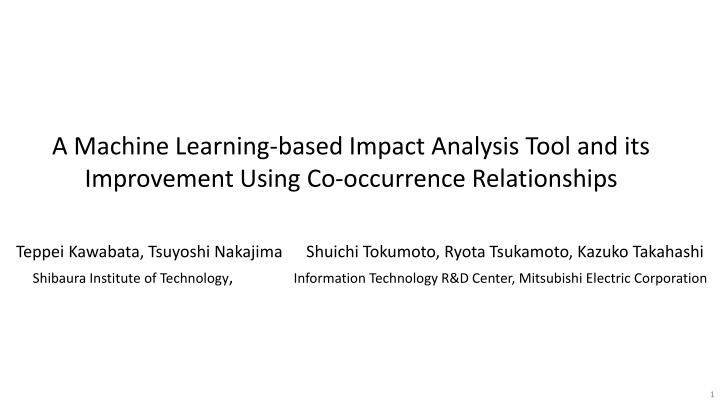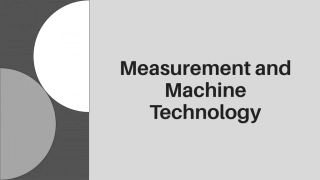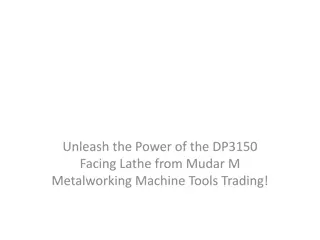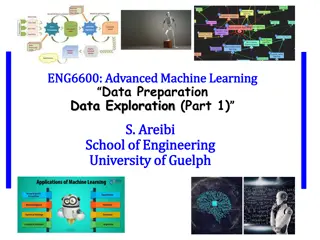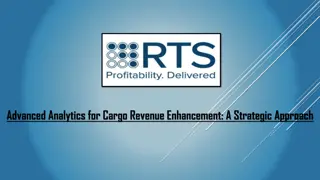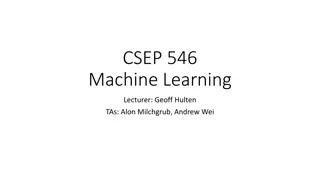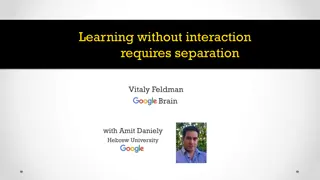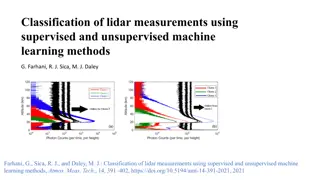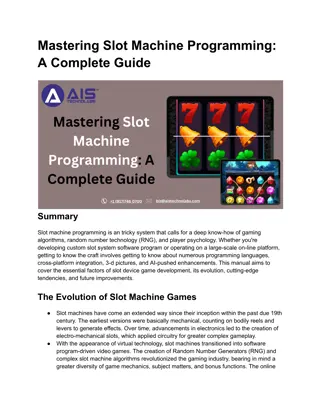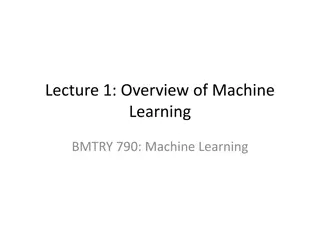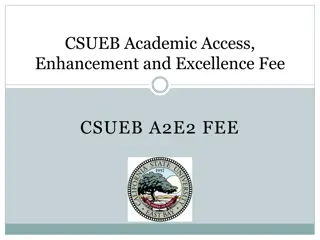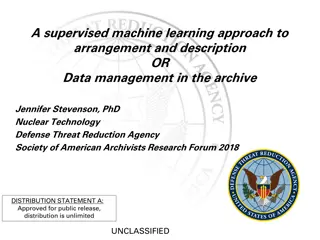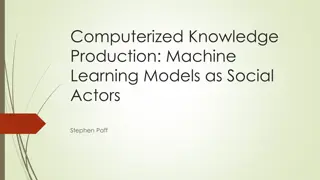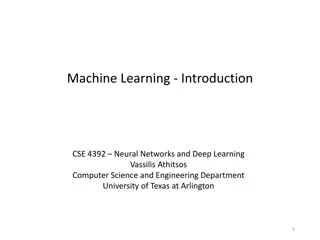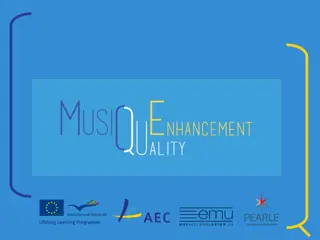Machine Learning Impact Analysis Tool and Enhancement
Importance of impact analysis in software engineering for controlling software evolution. Focus on proposed machine learning-based method for improved accuracy and efficiency in determining modification candidates. Comparison with conventional traceability method.
Download Presentation

Please find below an Image/Link to download the presentation.
The content on the website is provided AS IS for your information and personal use only. It may not be sold, licensed, or shared on other websites without obtaining consent from the author.If you encounter any issues during the download, it is possible that the publisher has removed the file from their server.
You are allowed to download the files provided on this website for personal or commercial use, subject to the condition that they are used lawfully. All files are the property of their respective owners.
The content on the website is provided AS IS for your information and personal use only. It may not be sold, licensed, or shared on other websites without obtaining consent from the author.
E N D
Presentation Transcript
A Machine Learning-based Impact Analysis Tool and its Improvement Using Co-occurrence Relationships Teppei Kawabata, Tsuyoshi Nakajima Shuichi Tokumoto, Ryota Tsukamoto, Kazuko Takahashi Shibaura Institute of Technology, Information Technology R&D Center, Mitsubishi Electric Corporation 1
TableofContents Software Engineering Lab 1. Conventional impact analysis methods and their problems 2. Proposed impact analysis method using machine learning 3. Four proposed algorithms in machine learning considering multilabel classification 4. For a comparative evaluation of the above four algorithms 2
Background: Importance of impact analysis Software Engineering Lab Software change impact analysis plays an important role in controlling software evolution in the maintenance of continuous software development. Modification candidates Large source code base Impact analysis (for a CR) Reuse-based small development projects Component 1 Component 4 Modification targets Component 5 CRCR Change request (CR) Component 3 Component 2 It is important to improve the accuracy and efficiency to obtain modification candidates. This is because it is difficult to automate determining whether a modification candidate is really a modification target or not, requiring a lot of efforts. However, the problem is that it depends on the amount of developer's knowledge about the source code base. 3
Conventional method: Impact analysis with traceability Software Engineering Lab Traceability: established linkage between multiple deliverables in the development process[1] Modification candidates Traceability links: information that shows the relationship between specific artifacts Problem 3 Too many modification candidates to review in reasonable amount of time Document A Design 1-1 : component a component b written requests request 1 request 2 : change request Modification targets component c Document B Design 1-2 : Problem 2 Problem 1 Need to establish traceability links in advance It is not applicable against new change requests that are not related to existing requests component d 4 [1]Udagawa Y.,et al. Traceability in Information System Development Standards: A Case Study and Its Future. IPSJ,2010,51.2.:150-158
Proposed method: Learning from change histories. Software Engineering Lab Our method is: To learn from a large number of change histories from past projects, and To learn from a large number of change histories from past projects, and To create modification candidates from a change request. To create modification candidates from a change request. List of modification candidates Change histories 1 component 5 2 component 3 3 component 28 Change design specification New Change Request Input Output Change Request Japanese) Input Text vectorization machine learning : The system does something when something happens. Request are between 20 and 400 characters in Japanese text. learning outputs Text vectorization machine learning Problems to be solved Modification target 1 Change to Not necessary to establish links in advance Applicable to new change requests Create modification candidates directly Modification target 2 Change to 5
Proposed method: composition of the algorithm Software Engineering Lab Change design document modified targets Change Request text Component 2 Component 4 extract component vector (when ML:0,1/ an inferring score) 0 1 Change Request vector Modification targets 0 1 0 0 0 0 Machine Learning Component Change Request (text) Vectorization 6
Proposed method:Howto implementsentencevectorization Software Engineering Lab Possible choices Vectorizing steps Full morphological selection Three implementations were evaluated Word extraction Extract nouns only 1 Selection by developer (Weighting) 1. Word extraction 2. Word Vectorization 3. Vector association Implementation 1 noun only word2vec simple average word2vec Word vectorization 2 Implementation 2 All word2vec doc2vec simple average Vector association Implementation 3 noun only word2vec doc2vec 3 weighted average doc2vec 7
Previous study: Neural Network as the machine learning component Software Engineering Lab Configuration of the NN Component vector(32) Vectorized sentence(100) The source code base used in our experiments has 32 components ReLu ReLu sigmoid ReLu full full full full output (32) input (100) coupling (500) coupling (300) coupling (100) coupling (1000) Hyper Parameters Number of studies performed: 50 Batch size: 50 Learning rate: 0.1 Loss function: binary cross-entropy error Weight parameter update method: SGD [2] Y. Iwasaki, Proposal of a system that recommends candidate program changes from requirement text by learning past change, 2020 8
Evaluation Methods and the results of the previous study Software Engineering Lab We defined three indexes for the given threshold of Sigmoid value. Modification candidate Sigmoid S ? A) Candidate Range ratio A component5 component5 component3 component29 0.31 component5 component5 T component3 component3 component3 0.30 0.28 0.27 S T S B) Accuracy in the candidate range B S component18 component18 component21 component18 component18 ? S T T C C) Missing rate Threshold 0.20 component21 component21 The results of the previous study. 0.19 component9 W component15 component15 component15 0.17 A)Accuracy in the candidate range 30.0 B)Percentage of correct answer C)Missing rate Threshold 0.15 component22 35.0 23.0 0.06 Missing modification targets has serious consequences. correct incorrect 9
Our idea to reduce missing rate Software Engineering Lab Hypothesis Dependencies arising from architecture A specific change pattern may cause modification of the same combination of components Layer A Component A2 Component A3 Component A4 Component A1 Rationale From the architectural point of view, some components may use common resources, or some call relationships exists between layers. call relationship Layer B call relationship Component B1 Component B2 Component B3 Component B4 Idea for improvement Adopting multi-label classifiers that model the co-occurrence relationship Common Resources 10
The four algorithms implementation to be evaluated Software Engineering Lab Previous study Neural Network(NN) Basic Methods for Handling Multilabel Classification Binary Relevance BR method Methods modeling co-occurrence relationships Label Powerset LP method Random k-Labelsets RAkEL methods 11
Basic Methods for Handling Multilabel Classification Software Engineering Lab Binary Relevance BR method Binary Relevance (BR) is a multilabel classification method, which learns a binary model for each label independently of the rest. This method does not model the co-occurrence relationships. Vectorized sentence Modification candidates 1 0 1 1 0 2 0 0 12
The four methods evaluated in this paper Software Engineering Lab Previous study Neural Network(NN) Basic Methods for Handling Multilabel Classification Binary Relevance BR method Methods using co-occurrence relationships Label Powerset LP method Random k-Labelsets RAkEL methods 13
Algorithm 1 for modeling the co-occurrence relationship Software Engineering Lab Label Powerset LP method LP is a multilabel classification method that models the co-occurrence relationship, considering all distinct combinations of labels as a different class and conducting a single-label classification for each. Vectorized sentence Modification candidate Estimation Results for each label in the class label1 label2 Probability of occurrence of class class label31 label32 Set[1] 1 set[1,2] 0.1 1 0 - - Set[2] 0 set[31,32] 0.2 - - 1 0 Set[3] 0 : : : : : : : 1 Set[4] set[1,2..,32] 0.3 1 0 0 1 0.1*1 + 0.3*1 Total evaluation 0 0.2*1 0.3*1 Disadvantage largeamount of calculation andover-learning 14
The four methods evaluated in this paper Software Engineering Lab Previous study Neural Network(NN) Basic Methods for Handling Multilabel Classification Binary Relevance BR method Methods using co-occurrence relationships Label Powerset LP method Random k-Labelsets RAkEL methods 15
Algorithm 2 for modeling co-occurrence relationships Software Engineering Lab Random k-Labelsets RAkEL methods RAkEL is a multilabel classification method that models the co-occurrence relationship, breaking the initial set of labels into a number of small random subsets, called labelsets and employing LP to train a corresponding classifier. Estimation Results for each Label label2 Set size k L pieces at random Class label1 label31 label32 component list set[1,31] 1 - 0 - Set LP method set[2,31] - 0 1 - LP method Set 2 : : : : : : set[1,2,..32] 0 0 - 1 LP method Set L Total evaluation T1/M1 T2/M2 T31/M31 T32/M32 T1: Number of cells whose estimated result is 1 Mi: Number of cells with estimated results 16
Experiment Software Engineering Lab Purpose of experiment To investigate whether the LP and RAkEL methods, which model the co- occurrence relationship, improve accuracy or not. The four methods were evaluated using the same field data. Multi-label classification method Classifier M1:Neural Network(NN) M2:BR method SVM M3:LP method SVM M4:RAkEL method SVM 17
Data used in the experiments Software Engineering Lab Training data(324) Change design specifications request sentence Total data is 405. component list (study) Test data(81) Multiple classification Method request sentence Modification candidate 18
Results of the experiment Software Engineering Lab The threshold was set so that the candidate range ratio is around 30 percent. Candidate Range ratioAccuracy in the Missing rate Method candidate range 30.00%(0.06) 18.00% 23.00% M1:NN Improved 5.9% M3 is 5.9% worse than M2 29.10%(0.06) 19.10% 17.10% M2:BR SVM 29.70%(0.06) 22.20% 23.00% M3:LP+SVM Improved 1.5% 29.50%(0.07) 24.50% 15.60% M4:RAkEL+SVM Result M2 is more accurate than M1 SVM is an excellent classifier M3 is less accurate than M2 Small number of data could have caused overlearning. M4 is the most accurate one. RAkEL provides the best results, meaning to model the co-occurrence relationship has a good effect to reduce missing rate. However their missing rates are not at enough level for the practical use. 19
Summaryand Future Issues Software Engineering Lab Summary We proposed an impact analysis method that learn changehistories to directly createmodification candidates. To improve the previous study, which use NN as the machine-learning component, we proposed a multi-label classification method considering the co-occurrence relationship The effectiveness of this method was confirmed by an experiment using BR, LP, and RAkEL methods. FutureIssues Application of an improved algorithm for the RAkEL method Validation by using the other data set (from OSS) 20
Supplementary data: Reasons for determining target values Software Engineering Lab Utilizes standard deviation ( ), a value often used in quality control ( interval): 68.3% 2 (2 interval): 95.4% 3 (3 interval): 99.7% z-distribution diagram 21
Supplementary material: Target projects used for the study Software Engineering Lab (annual) Project 2 Project 1 Project 3 Project 30 (average) change requests(10) change requests(10) change requests(10) change requests(10) Approximately 300 in total same program entity Each project modifies the program matrix for multiple change requests Create a change design document for each change request 22
